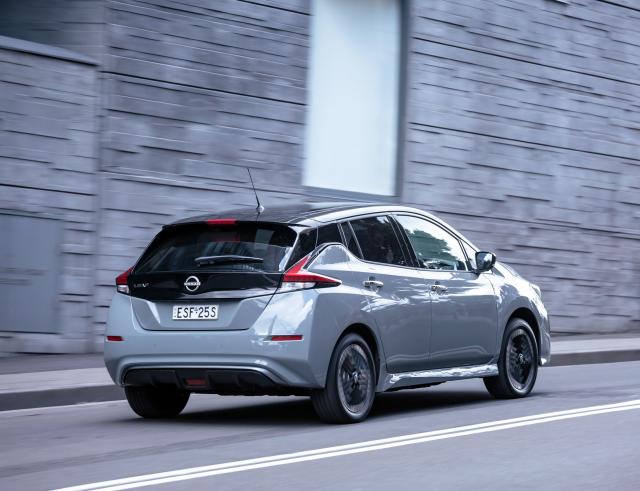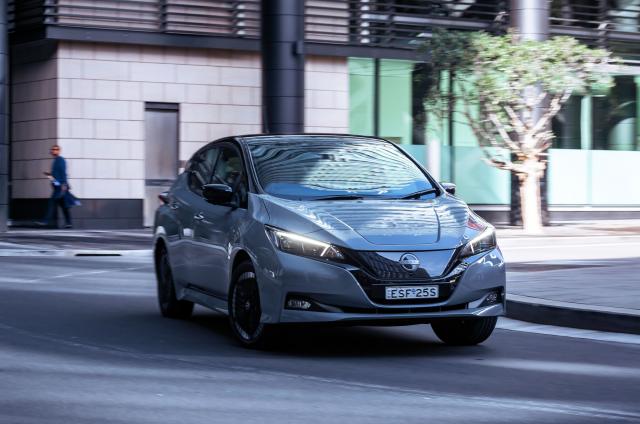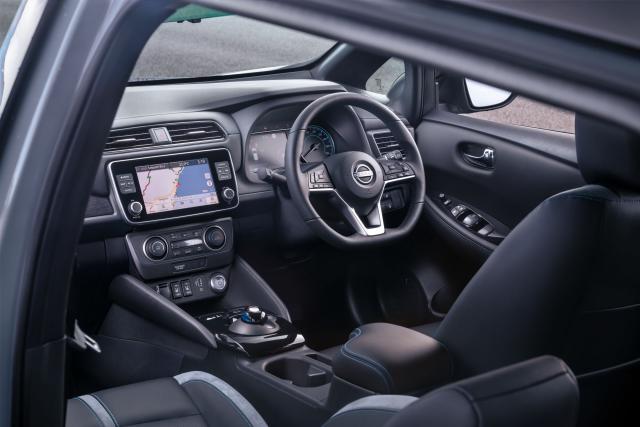Although it’s no longer a major player in the electric vehicle scene, Nissan Leaf holds an important role in automotive history, being the first mass-production vehicle of its type when it was launched worldwide back in 2010.
STYLING
The profile of the Leaf hasn’t changed significantly during its decade on the road. It comes with the same semi-coupe / SUV body that many of its competitors have adopted. Its lines are clean and simple with a sloping roofline, flowing headlights and blacked-out B and C pillars.
Changes for MY23 include new badging, revised front faux grille, darkened headlight trims, new rear diffuser and spoiler.
Likely to be the most noticeable change are a new design for the 17-inch alloy wheels which seem to polarise opinions. We love them, but others that have seen them immediately cringe.
INTERIOR
At around $60,000 plus on-roads Nissan Leaf sits at the more affordable level of EV pricing and it shows with a relatively bland interior when compared with the spectacular presentation of newer, but more expensive, cars like the Ioniq 5 and Kia EV6.
There is no powered seat option and height-only steering wheel adjustment.
Having said that the dashboard is neat and functional with most controls logically placed and easy to reach.
One of our pet hates are functions that need constant tapping on small keys on the touchscreen. By contrast Leaf uses four large round knobs – two for audio volume / channel change on the sides of the screen and two below for air conditioning temperature / fan speed. So much more sensible with much less driver distraction.
One new feature for the 2023 upgrade is the intelligent rearview mirror which doubles as a standard mirror but with a flick of a control becomes a built-in LCD monitor which displays images from a camera mounted on the rear of the vehicle for an unobstructed view.
Rear seat space is acceptable with enough leg and headroom for two taller occupants. A third adult in the centre would be wedged between the other two, made worse with a tall transmission tunnel on the floor.
There’s no folding armrest in the rear, nor air vents or USB ports.
Boot space is a pretty good 405 litres although the two charging cables and Bose audio located there. The loading lip is high with quite a big drop down to the cargo floor. The 60/40 split rear seatbacks can be folded down to extend storage to 1776 litres.
DRIVING
Composed is the perfect description of the Leaf’s performance. To match the improved output of the electric motor and converter, engineers enhanced the car’s chassis to improve stability.
The electric power steering is responsive with a nice linear feel.
Noise, vibration and harshness have been moderated with aerodynamic upgrades and structural rigidity, while the electric motor has been made quieter, despite generating more power and torque.
Leaf has what is called an e-Pedal, which at the flick of a switch on the centre console, allows the vehicle to be driven using the accelerator alone. The car comes to a smooth, gradual halt and is held stationary without the use of the brake pedal.
Unfortunately, on the Leaf the e-Pedal is either on or off unlike many competitors where the level of braking can be adjusted to suit conditions. We found that, in motorway conditions, the extra pressure needed to maintain traffic speed negated the benefit of the e-Pedal and we tended to use it only on downhill running.
Out on the open road ride handling proved to be excellent and the torque pick up will appeal to keen drivers. The absence of any engine sound combined with good external noise suppression and much less range anxiety adds further to the driving enjoyment.
Nissan lists a 385-kilometre range for the Leaf e+ although it showed up as 427 km when we picked up our test vehicle. During the week we did a couple of 3-hour top-up charges with our Wallbox home charger. In total we covered 352 kilometres and still showed a range of just over 200 km when we returned the car. So that projected 385 km range seems to be quite achievable.
There is tyre noise on rough road surfaces. But why wouldn’t there be with little or no sound from under the bonnet?
SUMMING UP
The enhancements added to the MY23 Leaf come at price with an increase of $1000 over the previous models taking the e+ to $61,490 and $50,990 for the standard 39 kWh Leaf at. On-road costs need to be added.
Premium purchase prices and refuelling convenience continue to be major hurdles for electric vehicles. But for those wishing to give it a go, the Nissan Leaf is as good as any petrol-powered close rival.









